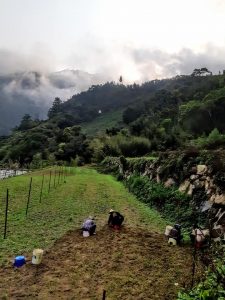In September 2019, thirty engaged scholars from diverging fields from Finland and Taiwan gathered to ponder upon the questions “What is Indigenous sustainabilities?”, “How can Indigenous perspectives contribute to sustainability science?” and “How can sustainability science become more sensitive towards Indigenous perspectives and worldviews?”.
An evident point of departure around the roundtable was that cultural sustainability – i.e. equality, healthy identities, societal trust and security – is the prerequisite for a sustainable future. Without it, we will have no sustainable societal structures to uphold our environmental solutions.
Cultural sustainability can, however, only be accomplished by making sure not to favor some voices over others. This means listening honestly to solutions worked out in each context. It also means not to impose upon others dominant ideas about what sustainability is in the first place.

Sustainable indigenous futures in the city: “We should challenge the bounded way of thinking of time and place”
Urbanization is a pressing issue for Indigenous Peoples all over the world today. As Pigga Keskitalo (Senior Researcher at the Department of Education, University of Lapland and Title of Docent at the University of Helsinki) pointed out, in Finland “90% of elders are living in the Sámi core area, and 75% of children outside the core area. So they are meeting only during the holidays or via telephone.”
This issue of urbanization calls for assessment from a sustainability perspective. It becomes a question of finding new arenas for sharing Indigenous and local knowledge between generations and of finding more community-relevant ways of arranging good care for elders. Concurrently, urbanization has become a question of the right and possibility to live as Indigenous in the city, far away from ancestral lands. However, how real is this divide between Indigenous lands and urban hubs?
Pirjo Kristiina Virtanen (Assistant Professor and head of Indigenous Studies at the University of Helsinki) brought forth the voices of her Apuriña collaborators in Brazilian Amazonia. Many of them envision homeland and cities, the urban and the rural, as non-separable entities. “My ancestors are everywhere”, one of her collaborators told her when speaking of their relationship with the land. “I think we should challenge the bounded way of thinking of time and place”, Virtanen concluded.

For many, moving to cities means living a translocational life, where ancestral lands remain the core of life and the core of Indigeneity. This also means that while Indigenous Peoples are expanding their living spheres, the importance of protecting Indigenous lands from state and business extractive industries remains crucial.
Indigenous concepts in the fight for sustainability
Indigenous Peoples have the role as advocates of sustainability. Indigenous organizations have advocated for a sustainable future together with environmental organizations with admirable results across the globe. Both movements have supported each other in getting their message through. They have offered each other new possibilities to take initiative.
At the same time, the expectations of environmental organizations and other stakeholders can also create pressure on Indigenous Peoples to live up to their judgement of what Indigeneity or sustainability is, and how it should be presented, creating tensions in some contexts.
Nikolas Sellheim (Researcher at HELSUS at the University of Helsinki and Scott Polar Research Institute at the University of Cambridge) pointed out that, in some cases, Indigenous rights are being questioned and dismissed when their practices are not perceived by those in political power positions as fitting into the hegemonic ideas of what traditions and sustainability are.
Hanna Guttorm (Postdoctoral Fellow in HELSUS and Indigenous Studies at the University of Helsinki) drew our attention to the fact that in Northern Sámi language for example, there has previously been no concepts for nature and culture as we know them now. Reetta Toivanen (Professor of Sustainability Science [indigenous sustainabilities] at HELSUS, University of Helsinki) argues at the same time that in dominant state thinking, nature and culture is often presented as binaries. This binary is sometimes misused to situate Sámi outside of politics, in the apolitical nature.
Jolan Hsieh / Bavaragh Dagalomai (Professor of the Department of Ethnic Relations and Cultures, College of Indigenous Studies, National Dong Hwa University) also remarked how for the Siraya people in Taiwan, environment and people, nature and culture, were never understood to be separate. Hsieh concludes, “In science we see the human being and the environment separately, but it is all connected, sky father, mother earth”.


Conclusion: “We do not need to re-invent the wheel”
Attempting to summarize the roundtable discussion into a public blogpost invited us to reflect upon questions such as “Who and where we are when we speak?”, “Who we speak with, for or on the behalf of?”, and “With what consequence?” These are not new questions, but indeed questions that everyone should be concerned about.
As argued in the roundtable, such questions of voice and power are intrinsically connected to which concepts we choose to use. All concepts give voice to some while leaving other experiences silenced. In this regard, mainstream sustainability science still needs to decolonize some commonly used imaginaries and deconstruct dominant binaries. Being open to diverse views of how our world is assembled, will create a more sustainable future.
Nevertheless, have we not talked about the balance of voices, positionality and the power of concepts a million times before? This is what the roundtable in the end came down to – a plea for those in power positions to listen to the solutions, listen to the knowledges that already exist.
Several Indigenous development projects challenge the dominant concepts used in sustainability science and rely on local forms of governance. One example is the Indigenous and Community Conserved Area (ICCA) Consortium. William Hui-yen Hsu (Professor at the Department of Law at the National Dong Hwa University) brought forth the movements for food sovereignty by Indigenous Peoples in Taiwan, where they are fighting for the use of sustainable food systems they had in place before colonization. As Virtanen concluded: “We do not need to re-invent the wheel”.
The blogpost is based on the second roundtable discussion organized on the topic of Indigenous Peoples and sustainability science by Reetta Toivanen, Professor of Sustainability Science (indigenous sustainabilities), at the Helsinki Institute of Sustainability Science at the University of Helsinki on 10 September 2019.”
Nora Fabritius
Nora Fabritius is a doctoral student in the Doctoral Programme in Social Sciences at the University of Helsinki. She is affiliated with The Centre for Research on Ethnic Relations and Nationalism (CEREN) at the Swedish School of Social Science and the Faculty of Social Sciences. She began working on the blogpost while working at The Centre of Excellence in Law, Identity and the European Narratives (EuroStorie) at the University of Helsinki.
Wasiq Silan (I-An Gao)
Wasiq Silan (I-An Gao) is descendent of the Tayal people from the northern region of Taiwan and completing her doctoral degree in Political, Societal and Regional Change (PSRC) at the University of Helsinki. She is a 2017-2018 and 2020 grantee of a Finnish Cultural Foundation and is currently affiliated to the Centre for Research on Ethnic Relations and Nationalism (CEREN).
References and further reading
Gao, I-A (Silan Wasiq). Worthy lives and building homes. Blog: Rasismista ja rajoista: Maailma rasisminvastaisten tutkijoiden silmin, 15 May 2018.
Hsieh, J. (2016). Silent Crusade? Indigenous Women in Taiwanese Indigenous Movements. Lectora: revista de dones i textualitat, 67-82.
Johnson, J. T., R. Howitt, G. Cajete, F. Berkes, R. P. Louis & A. Kliskey (2016). Weaving Indigenous and sustainability sciences to diversify our methods. Sustainability Science, 11(1), 1-11.
Keskitalo, P. (2019). Nomadic Narrative of Sámi People’s Migration in Historic and Modern Times. Uusiautti, S., & Yeasmin, N. (2019). Human Migration in the Arctic : The Past, Present, and Future, 31-65. Palgrave Macmillan.
Kuan D.-W. (2014). Kōngjiān zhìxù, dìlǐ zàixiàn yǔ shēngtài zhèngzhì: Táiwān shāndì zīyuán lìyòng/bǎoyù de lìshǐ dìlǐ huígù (Spatial Order, Geographical Representation and Political Ecology: A Geo-historical Review of the Resource Exploitation / Conservation in the Mountain Indigenous Area of Taiwan). Taiwan Journal of Indigenous Studies, 7(1), 159-197.
Nxumalo, F., & S. Cedillo (2017). Decolonizing place in early childhood studies: Thinking with Indigenous onto-epistemologies and Black feminist geographies. Global Studies of Childhood, 7(2), 99-112.
Te Pou o te Whakaaro Nui (2017). New Māori glossary helps bridge the gap in understanding mental health addiction and disability issues, posted 26 June 2017.
Toivanen, R. & N. Fabritius (2020). Arctic youth transcending notions of ‘culture’ and ‘nature’: emancipative discourses of place for cultural sustainability. Current Opinion in Environmental Sustainability 43, 58-64.
Sellheim, N. (2020). The Evolution of Local Involvement in International Conservation Law. Yearbook of International Environmental Law 28.
Virtanen, P. K., L. Siragusa, & H. Guttorm eds. (2020). Special Issue: Indigenous Conceptualizations of “Sustainability”. Current Opinion in Environmental Sustainability 43.
Photos by: Heidi Konttinen, Celine Lityo on Unsplash and Yih-Ren Lin
